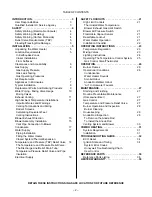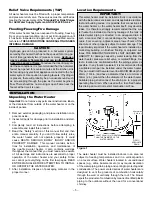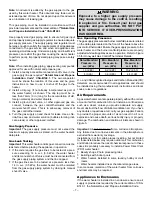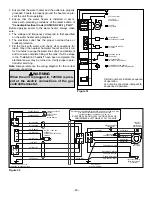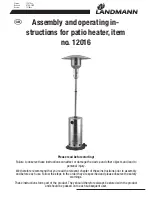
Relief Valve Requirements (T&P)
All water heaters must be
fi
tted with a proper temperature
and pressure relief valve. These valves must be certi
fi
ed as
meeting the requirements of the
"Standard For Relief Valves
For Hot Water Supply Systems, ANSI Z21.22/CSA 4.4"
.
Flooding/Freezing/Fire Damage
If this water heater has been exposed to
fl
ooding, freezing,
fi
re or any unusual condition, do not put it into operation until
it has been inspected and approved by a quali
fi
ed service
technician.
THESE CONDITIONS CAN RESULT IN UNSEEN
INTERNAL DAMAGE.
CAUTION
Hydrogen gas can be produced in a hot water system
served by this heater that has not been used for a long pe-
riod of time (generally two (2) weeks or more).
Hydrogen
gas is extremely
fl
ammable and can ignite when ex-
posed to a spark or
fl
ame.
To reduce the risk of injury un-
der these conditions, it is recommended that the hot water
faucet be opened for several minutes at the kitchen sink
before using any electrical appliance connected to the hot
water system. Use caution in opening faucets. If hydrogen
is present, there will probably be an unusual sound such
as air escaping through the pipe as the water begins to
fl
ow. There should be no smoking or open
fl
ame near the
faucet at the time it is open.
INSTALLATION
Unpacking the Water Heater
Important
: Do not remove any permanent instructions, labels,
or the data label from outside of the water heater or on the
inside of panels.
Remove exterior packaging and place installation com-
ponents aside.
Inspect all parts for damage prior to installation and start-
up.
Completely read all instructions before attempting to
assemble and install this product.
Read the “Safety” section of this manual first and then
entire manual carefully. If you don’t follow safety rules,
the water heater will not operate properly. It could
cause DEATH, SERIOUS BODILY INJURY AND/OR
PROPERTY DAMAGE. This manual contains instruc-
tions for installation, operation, and maintenance of
the gas-fired water heater. It also contains warnings
throughout the manual that you must read and be aware
of. All warnings and instructions are essential to proper
operation of the water heater and your safety. Since
we cannot put everything on the first few pages, READ
ENTIRE MANUAL BEFORE ATTEMPTING TO INSTALL
OR OPERATE THE WATER HEATER.
After installation, dispose of packaging material in the
proper manner.
•
•
•
•
•
Location Requirements
IMPORTANT:
This water heater must be installed strictly in accordance
with the instructions enclosed, and all applicable electrical,
fuel and building codes. It is possible that connections to
the water heater, or the water heater itself, may develop
leaks. It is therefore strongly recommended that the wa-
ter heater be installed so that any leakage of the tank or
related water piping is directed to an adequate drain in
such a manner that it cannot damage the building, fur-
niture,
fl
oor covering, adjacent areas, lower
fl
oors of the
structure or other property subject to water damage. This
is particularly important if the water heater is installed in a
multi-story building, on
fi
nished
fl
ooring or carpeted sur-
faces. THE MANUFACTURER WILL NOT ASSUME ANY
LIABILITY for damage caused by water leaking from the
water heater, pressure relief valve, or related
fi
ttings. Se-
lect a location as centralized within the piping system as
possible. In any location selected, it is recommended that
a suitable drain pan be installed under the water heater.
This pan must limit the water level to a MAXIMUM depth of
45mm (1 3/4 in.) and have a diameter that is a minimum of
50mm (2 in.) greater than the diameter of the water heater.
Suitable piping shall connect the drain pan to a properly
operating
fl
oor drain. When used with a fuel-
fi
red heater,
this drain pan must not restrict combustion air
fl
ow.
45mm max
(1 3/4 in.)
AT LEAST 50mm (2 in.) GREATER
THAN THE DIAMETER OF THE
WATER HEATER.
PIPE TO
ADEQUATE
DRAIN
Figure 1
The water heater must be installed indoors in an area not
subject to freezing temperatures and in a vertical position
on a level surface. Water heaters located in unconditioned
spaces (e.g., attics, basements etc.) may require insulation
of the water piping, drain piping and venting to protect against
condensation. The power vented series of water heaters are
designed to vent the products of combustion horizontally
through the wall or vertically through the roof. The blower
expels the products of combustion by means of certi
fi
ed plastic
piping to the outdoors without the need for a conventional
chimney.
– 5 –


